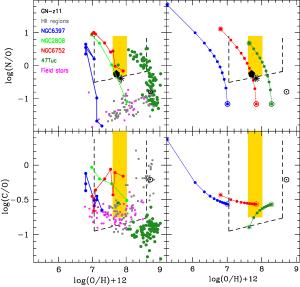Blog
The Star Beasts
16 May 2023
Globular clusters are odd beasts. They aren’t galaxies, but like galaxies, they are a gravitationally bound collection of stars. They can contain millions of stars densely packed together, and they are old. Really old. They likely formed when the universe was only about 400 million years old. But the details of their origins are still unclear.
We know globular clusters are old because they don’t exhibit any star production, and the stars they contain are old, low-metal stars. This suggests that the clusters formed during the early star-formation period of the universe, and have long since depleted or cast off the dust and gas to form new stars. The stars of a globular cluster have similar ages and chemical compositions, which suggests a globular cluster formed from a single large molecular cloud.
At least that had been the theory. But as astronomers studied globular clusters more closely, they found odd chemical variations within the stars of a particular globular cluster. Some stars have distinct abundances of elements such as oxygen, nitrogen, and sodium not seen in other cluster stars. If the stars of a globular cluster form from the same molecular cloud at roughly the same time, why would some stars be so distinct? A new study published in Astronomy & Astrophysics points to a solution.1
 Charbonnel, et al
Charbonnel, et alIn this study, the authors looked at a high redshift globular cluster known as GN-z11. This cluster is at a redshift of z = 10.6, so we see it at a time when it was only tens of millions of years old. Using observations from the James Webb Space Telescope (JWST) they found it a dense cluster of stars active with star production. They also found the cluster had a high relative abundance of nitrogen. This is interesting because such high nitrogen levels are likely produced within early supermassive stars.
Astronomers have long thought that many of the first generations of stars were supermassive stars. They would have been comprised purely of hydrogen and helium, with masses 5,000 to 10,000 times that of the Sun. These stellar beasts would only have only lived for a few hundred thousand years before dying in a cataclysmic explosion. Through their deaths, these stars would have seeded the universe with elements such as carbon, nitrogen, and oxygen.
Another possible solution to the nitrogen abundance of GN-z11 is through the by-product of second-generation Wolf-Rayet stars, which experience an extended period of casting off their outer layers before finally dying. But given the age of GN-z11, that doesn’t seem likely. The team would like to look at other high-redshift globular clusters to distinguish between these two possibilities.
If the supermassive star model is correct, it could be that globular clusters form in a way similar to galaxies. Just as supermassive black holes drive the early formation and star production of galaxies, supermassive stars might be the seeds for globular clusters.
Charbonnel, C., et al. “N-enhancement in GN-z11: First evidence for supermassive stars nucleosynthesis in proto-globular clusters-like conditions at high redshift?.” Astronomy & Astrophysics 673 (2023):L7. ↩︎